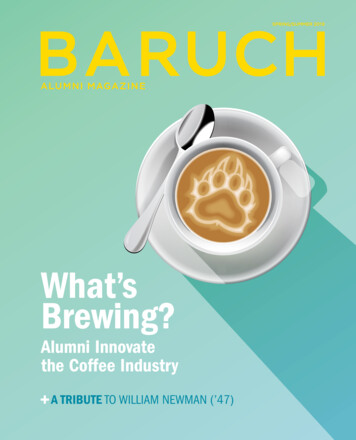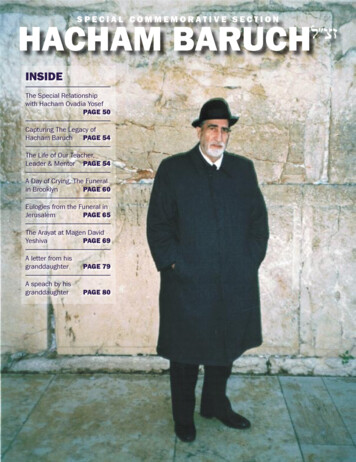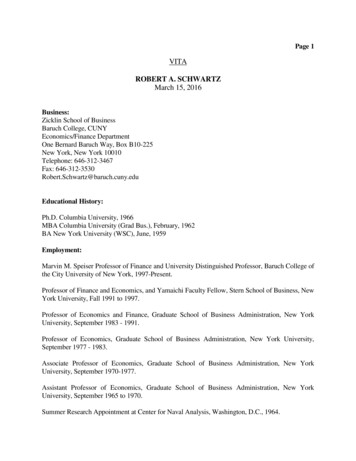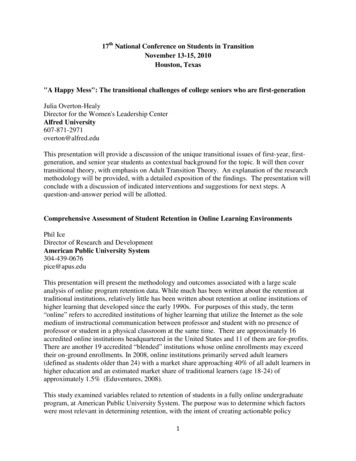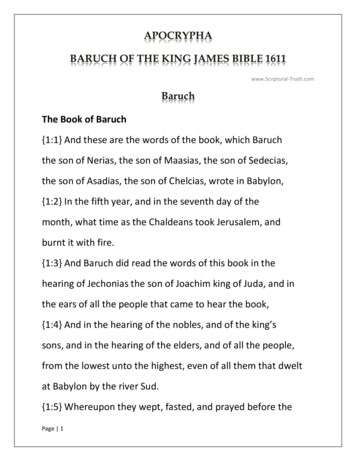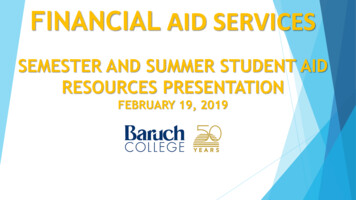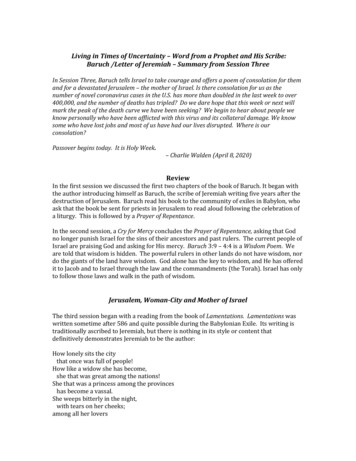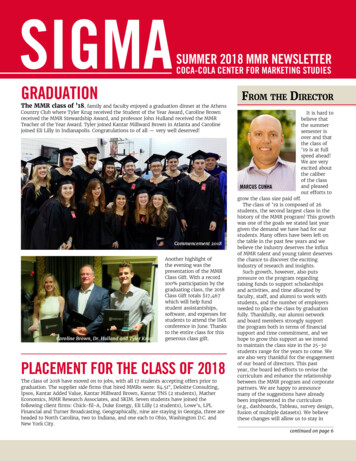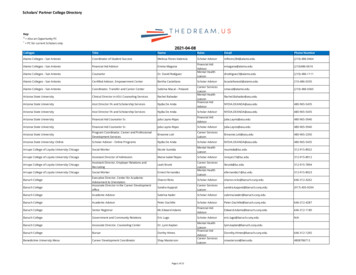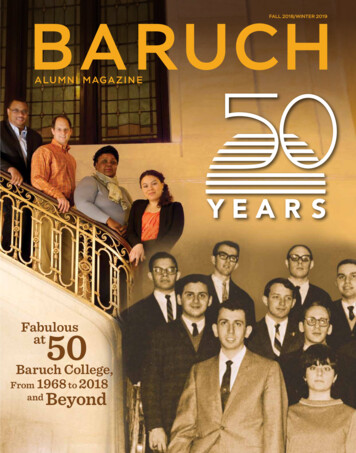
Transcription
BA RUCHFALL 2018/WINTER 2019A L U M N I M AG A Z I N EFabulousat50Baruch College,From 1968 to 2018andBeyond
Message from the PresidentThis commemorative issue of Baruch AlumniMagazine celebrates our 50th anniversaryas a fully independent senior college inThe City University of New York system.Since 1968 Baruch has been dedicated to elevatingthe prospects of our talented and diverse studentbody, providing them with the intellectual skillsand tools needed to advance both professionally andpersonally. The College earns high marks in nationaland regional rankings for its academic programsand is consistently held up as a model for studentsocial mobility, including—most recently—a fourthconsecutive year in the #1 position on CollegeNET’sannual Social Mobility Index (see page 3).By these and numerous other indicators, Baruch ison strong ground and has a great outlook for theyears ahead.All three of our schools are named and endowed,and we are the only CUNY college that can claimthis distinction. The College’s overall endowmenthas increased by almost 60 percent, and this includesthe largest single gift—of 30 million—to nameand endow the Austin W. Marxe School of Publicand International Affairs.We have strategically expanded our globalprogramming, which now includes innovativegraduate-level, degree-granting partnerships withuniversities in China, Israel, and Italy, as wellas a broad range of study- and work-abroadopportunities for undergraduates. Each yearnumerous Baruch students win competitivegrants and fellowships for international study,including U.S. Fulbright awards, BorenFellowships, Benjamin A. Gilman InternationalScholarships, and U.S. Department of StateCritical Language Scholarships.The physical campus is also advancing, withseveral major improvement projects under way:construction of the permanent Clivner FieldPlaza on 25th Street; development of the newAllen G. and Mary E. Aaronson Student Center,which will be located in the lower level of theMadison Square Post Office building on 23rdand 24th Streets; and renovation of the historicField Building at 17 Lexington Avenue (aka17 Lex).I also take pride in the amazing, collaborativenetwork of alumni that spans the globe. I haveenjoyed meeting many of you at events aroundthe U.S. and abroad, and I look forward tohaving our paths cross again in the future.In the spirit of the season, I wish you happyholidays and a healthy, prosperous 2019!“Since 1968 Baruch has been dedicated to elevatingthe prospects of our talented and diverse student body,providing them with the intellectual skills and toolsneeded to advance both professionally and personally.”President’s photo by Karsten MoranSincerely,MITCHEL B. WALLERSTEINPresident, Baruch College
IN THIS ISSUEFALL 2018/WINTER 20196 COVER STORYFabulous at 50: Baruch CelebratesFive Decades of Providing Access tothe American DreamBaruch Alumni MagazineCheryl de Jong–LambertDirector of CommunicationsEDITOR IN CHIEF:Diane HarriganGregory M. LeporatiThe story of Baruch College’s independence from CCNYis nothing short of extraordinary. As we celebrate the 50thanniversary of this milestone, we invite you to take a strolldown memory lane and see how Baruch and New York City have changed over the past five decades—and what our alumni hope to see from the College over the next 50 years.SENIOR EDITOR:3 CAMPUS HIGHLIGHTDavid Shanton, Vice President of CollegeAdvancementRankings & AwardsRecognition continues to pour in for Baruch College. Four professors in the Weissman School of Artsand Sciences earn Guggenheim and Fulbright Awards for 2018–19, and the College—with two#1 rankings for social mobility, from CollegeNET for the fourth consecutive year and The Chronicleof Higher Education—continues to lead the national dialog on higher education and social mobility.12 ALUMNI SPOTLIGHTHigh Fashion Meets Higher Education:Nana Yoshida (’09, MA ’17)Accomplishments happened fast for Tokyo native Nana Yoshida,who came to NYC to pursue her dream of becoming a fashiondesigner/entrepreneur. Not only did she establish her own clothinglabel, she also earned a Zicklin BBA and a Weissman MA in ArtsAdministration. “Each degree came at the right moment,” she says.ALSO INSIDE5 NEWS & NOTES10 CLASS NOTESDeep-sea adventures ofthe virtual kind enchantedguests at this year’s 17 LexSociety Reception, heldat “National GeographicEncounter: Ocean Odyssey”in Times Square.Motorcyclist, pilot-in-training,and advertising pioneer Castor A.Fernández (’66, MBA ’68)revolutionized Hispanicmarketing with his innovative“sub-segmentation” approach.ON THE COVER: Even with the phenomenal growth of Baruch’s campus, some locations remain perennialfavorites for student photos. Among those is the spiral staircase in the lobby of 137 East 22nd Street,known today as Steven L. Newman Hall. Our before-and-after cover fuses two images: Marxe ExecutiveMPA students from the Class of 2014 and members of the American Society for Personnel Administrationin 1967. Shown: Class of 2014 EMPA alumni (from top left): Meishay Gattis, Gregory DeStefano,Annmarie S. Clarke, Mery J. Hackman; 1967 society members (first row) Michael Stern (’67), BrendaDavis; (second row) Neal Savino, William Weigand (’69), Arthur Goldberg (’67); and (third row)Joseph Farbowitz (MBA ’70), Michael Murphy (’67), Jerry Drutman (’68), Joe Colucci (’67). Present-dayphoto by Elena Olivo; archival photo from The Lexicon.GRAPHIC DESIGN:VanguardOFFICE OF ALUMNI RELATIONSAND VOLUNTEER ENGAGEMENTJanet B. Rossbach, Director of AlumniRelations and Volunteer EngagementBaruch Alumni Magazine 2018 by Baruch CollegeThe City University of New YorkPlease address all editorialcorrespondence to:Baruch Alumni MagazineOffice of Communications, Marketing& Public AffairsOne Bernard Baruch Way, Box A-1503New York, NY 10010-5585email: communications@baruch.cuny.eduPlease send all inquiries aboutthe Baruch College Fund, as well asaddress changes, to:The Baruch College FundOffice of College AdvancementOne Bernard Baruch Way, Box A-1603New York, NY 10010-5585phone: 646-660-6060email: bcf@baruch.cuny.eduFor information about alumni programsand activities, please contact:Baruch College Office of Alumni Relationsand Volunteer EngagementOne Bernard Baruch Way, Box A-1603New York, NY 10010-5585phone: 646-660-6097email: alumni@baruch.cuny.eduonline: alumni.baruch.cuny.eduBaruch Alumni Magazine onlinebaruch.cuny.edu/bamFALL 2018/WINTER 2019 1
NEWS&NOTESLast February Chimaechi Ekekeugbor (’18)finished his basketball playing days at BaruchCollege with 2,000 career points.He is the first Bearcat and one of onlytwo players in CUNY Athletic Conference(CUNYAC) men’s basketball history to score2,000 points or more. Nicknamed Chima,he reached the milestone in his final gameby scoring 37 points, his largest haul inhis four years and 114 games as a Bearcat.During his senior season, the 6' 5" marketingmajor averaged 18.6 points, 10.1 rebounds, and3.0 assists per game and was voted the 2017–18CUNYAC Most Valuable Player.Chima, who completes his bachelor’s degree thisterm, is considering his postcollegiate options, whichinclude playing professional basketball in Europe as wellas pursuing a career in marketing with the goal of one dayworking for an NBA team. This summer he worked inthe New York Knicks’ Kids Summer Camp, serving as acoach and instructor.Off the court, Chima was a popular student-athlete whofinished his playing days as a Second Team Basketball All-American,one of the highest national honors bestowed on a student-athlete.“Chima has carved out quite a legacy here at Baruch,” saysHead Coach John Alesi (’03). “He has established himself asone of the top players in our program’s history by havingan incredible work ethic and approach to life. He is theepitome of what it means to be a Baruch Bearcat.”—JOHN NEVESALUMNI ATHLETES:Save the date for this academicyear’s Athletics Alumni Day onSaturday, Jan. 12.Neighborhood BeatROZ BERNSTEIN REPORTING DAYEXPLORES CHINATOWNResidents’ access to affordable housing,adequate healthcare, and ESL serviceswere among the topics raised by Baruchstudent journalists during a multisession,daylong learning tour of New York City’sChinatown. The neighborhood was thefocus of the Second Annual Roz BernsteinReporting Day, organized by Gisele Regataoand Emily Johnson, faculty members inthe Department of Journalism and theWriting Professions. Seventy studentsfrom four classes participated.At the Chinese-American PlanningCouncil, for example, students heardfrom Allegra Cole, the former Chinatownreporter for DNAinfo, who gave them tipson neighborhood beat reporting. Studentsalso visited the Museum of Chinese inAmerica and took part in an architecturewalking tour.Excursion namesake Roslyn Bernstein,PhD, professor emerita of journalism,joined the group. “There is no better wayto teach journalism than to explore thelocal,” says Dr. Bernstein. “Journalistsneed to dig into a neighborhood and findout what makes it tick—unravel its past,dissect its present, to illuminate its future.I can’t wait to read the students’ storiesand listen to their podcasts.”Says co-organizer Ms. Regatao, “Ofcourse the most passionate and engagedperson on the tour was Roz herself. Shecontinues to inspire all of us.” Bernsteinretired from Baruch in 2016 after morethan 40 years of distinguished teaching,service, and mentoring.Men’s basketball will take on Lehman College inBaruch’s Athletic & Recreation Complex (aka theARC). Also scheduled is a Tribute to Ray Rankis,beloved longtime coach of the men’s basketballteam and former athletic director, who died in June.Visit alumni.baruch.cuny.edu for more information.Former forward Chimaechi Ekekeugbor (’18) became the first Baruchmen’s basketball player and only the second in CUNYAC history to score2,000 or more career points.2 BARUCH ALUMNI MAGAZINE baruch.cuny.edu/bamThe day’s eponymous professor (right) joinedjournalism students and professors in Chinatown.Basketball photo by Denis Gostev (’13); Reporting Day photo by Gisele RegataoMr. Big Shot: History Madewith 2,000 Points
NEWS&NOTESGuggenheims and Fulbrights: Prestigious Awards for ProfessorsFour Weissman School faculty membershave been recognized with prestigiousfellowships and awards for 2018–19.Esther Allen, PhD, in the Department of ModernLanguages and Comparative Literature, andAlison Griffiths, PhD, of Communication Studies,were awarded Guggenheim Fellowships.Thomas Desch-Obi, PhD, in History, andBarbara Katz-Rothman, PhD, in Sociologyand Anthropology, received Fulbright awards.Dr. Allen, named a Guggenheim Fellow fortranslation, will complete the translation of twonovels by the Argentinian writer Antonio DiBenedetto (1922–86): The Silentiary andThe Suicides. She has already translated DiBenedetto’s Zama, today considered a classic.Dr. Griffiths, named a Guggenheim Fellowfor film, video, and new media studies, isusing her fellowship to write a book titledNomadic Cinema: A Cultural Geography of theFilm and media studies scholar Alison Griffiths, PhD,professor in the Weissman School’s Department ofCommunication Studies, is among a select group—173 scholars, artists, and scientists chosen from almost3,000 applicants for a 2018 Guggenheim Fellowship.Expedition Film, which examines expeditionfilmmaking in the early 20th century.Dr. Desch-Obi received a Fulbright U.S.Scholar Grant to support his research onthe history of endangered Afro-Colombianmartial arts known collectively as grima.Beginning January 2019, he will spendseven months in Colombia, conductingarchival and ethnographic research, andwill continue work on the monographHombres Históricos: Grima and theAfro-Colombian Struggle.Dr. Katz-Rothman received a FulbrightSaastamoinen Foundation DistinguishedChair in Health Sciences Award, whichprovides an American scholar with theopportunity to conduct research at theUniversity of Eastern Finland. She is studyingthe history of the inherited metabolicdisorders known as “the heritage diseases.”Top That: Baruch in the Spotlight for Social Mobility SuccessGriffiths photo by Manny RomeroThe dog days of summer were far from lethargic at Baruch, as the College received news of its #1 ranking for social mobility amongfour-year public institutions, courtesy of The Chronicle of Higher Education’s 2018 Almanac of Higher Education. The almanac isa yearly roundup of major stories and research in the world of higher education.The Chronicle’s ranking was drawn from the widely reported 2017 study “Mobility Report Cards: The Roleof Colleges in Intergenerational Mobility,” in which a team of economists tracked students from nearly everyU.S. college, including nongraduates, and measured their subsequent earnings against millions of anonymoustax filings and financial aid records.“We are pleased to be recognized by The Chronicle for our social mobility leadership and academicsuccess,” says Baruch College President Mitchel B. Wallerstein, PhD. “Baruch’s extremely low tuition,high-quality academic programs, and extensive support services have helped generationsof students, and their families, move permanently to a higher economic status.”Baruch’s success propelling high-achieving, low-income students up the socioeconomicladder has been garnering national attention for years. CollegeNET named Baruch a 2018Social Mobility Innovator and ranked the College #1 on its annual Social Mobility Index forfour years running. The College is also prominently featured in bestselling author StevenBrill’s latest book, Tailspin: The People and Forces Behind America’s Fifty-Year Fall—and ThoseFighting to Reverse It (Knopf, 2018).So far this year, the College has also received top placements and praise from such prominentorganizations as U.S. News & World Report, Forbes, Kiplinger’s Personal Finance, and the PrincetonReview. Of the myriad accolades, President Wallerstein proudly says, “The American Dream is aliveand well at Baruch.”baruch.cuny.edu/bam FALL 2018/WINTER 2019 3
NEWS&NOTESEye-Opening: Baruch’s New Virtual Reality LabWhat if biology students could perform dissections in three-dimensional spaceor history students could be instantly transported to the Anne Frank House inAmsterdam? At the Hedwig Schindler Virtual Reality Lab, now they can. Locatedon the sixth floor of the Newman Vertical Campus, the Weissman School of Arts andSciences’ facility opened in Spring 2018 with a gift from Mrs. Hedwig Feit (née Schindler).The first of its kind at Baruch, the Schindler Virtual Reality Lab is in keeping with the WeissmanSchool’s mission to deliver forward-looking student experiences and with the College’s greatercommitment to technology and curricular development.The lab, which accommodates 20 students and offers a variety of technologies, putsthe emphasis on immersive, undergraduate-centered learning and teaching. Equipmentincludes virtual reality (VR) headset goggles, 3D VR eyewear, and hand-held sensorsand interactive controllers. Says Weissman Dean Aldemaro Romero Jr., PhD, thedriving force behind the lab, “No generation of students is as highly visual, digitallysavvy, and excited about hands-on learning as the current generation.”For faculty the VR lab serves as a research and testing grounds, a place to explore theeducational potential of existing VR experiences and to customize content. To date, professorsfrom the natural sciences, social sciences, and arts have submitted proposals that integratethe lab into their courses in ways that promise to revolutionize what and how they teach.“With this technology, we can dramatically change Baruch’s liberal arts and sciencecurricula,” says Dean Romero.Designed to increase student engagement andlearning, the Hedwig Schindler Virtual Reality LabDavid P. Christy, PhD, provost and senior vice president for academic affairs, agrees,has created a stir. Says Weissman School Associate“We are going to see tremendous growth and development in this technology, withDean Gary Hentzi, PhD, “The learning experienceapplications to student learning and teaching as yet unimagined.”in a virtual space absorbs students entirely.”The excitement was palpable onAug. 23 as the largest class offirst-year students in more thana decade crowded into Mason Hall inthe Lawrence and Eris Field Building at17 Lexington Avenue for New StudentConvocation, the annual ceremony thatofficially welcomes students to the Baruchcommunity. In addition to launching the2018–19 academic year, the gathering alsokicked off the College’s yearlong 50thanniversary celebration.Joined on the platform by a party offaculty and staff VIPs, all in academicregalia, Baruch College President MitchelB. Wallerstein, PhD, greeted the 1,650newcomers and premiered Baruch College:Celebrating 50 Years of Access to Excellenceand the American Dream, the first in a seriesof anniversary-themed videos. It featuresalumni from the sixties recounting Baruch’sperilous struggle to survive and become anindependent senior college in the CUNYsystem. It was a hit!Russell Shorto, author of this year’spre-assigned First-Year Text, Island atthe Center of the World: The Epic Story ofDutch Manhattan and the Forgotten ColonyThat Shaped America, served as the event’skeynote speaker. He told the newly mintedJoin us!4 BARUCH ALUMNI MAGAZINE baruch.cuny.edu/bamBearcats that “progressive 17th-centuryDutch principles—tolerance, free trade,and social mobility—are part of America’sand especially New York City’s DNA. . . .It’s why you’re here and why Baruch’s here.”Shortly after the student-centered events,on Sept. 13, the Office of the Provostorganized Baruch’s Inaugural FacultyConvocation. A celebration of facultyexcellence and dedication, the traditionin-the-making offered an opportunity torecognize achievements and service andwelcome new members. More than 60new, full-time faculty members will joinBaruch in 2018–19.These events all celebrated a commontheme: Baruch’s enduring legacy as anagent of social and economic mobility.Baruch is celebrating its 50th anniversary through Commencement 2019in late spring. Check your mailboxes—digital and snail—for invitations to special events.Schindler Lab photo by Nadia GomezSteeped in History, Baruch Embraces the Future
NEWS&NOTESGlobetrotting: Baruch Programs & AmbassadorsOcean Odyssey photo by Sirin Samman; globe art by Samantha Azizo“There’s isn’t a single aspect of the Baruch experience that isn’t influenced byglobalism,” says H. Fenwick Huss, PhD, Willem Kooyker Dean of the ZicklinSchool of Business. Baruch’s students, faculty, and staff continue to both contributeto and benefit from the College’s expansion of its global footprint and perspectives. Hereare some highlights.At the programmatic level, Baruch has established a comprehensive global businesseducation program, offering more than a half dozen new, dual master’s degree programsin partnership with universities in China, Italy, and Israel, with additional relationshipsunder development in Vietnam, India, South Korea, and Argentina. Two of these programsrecently celebrated milestones. The inaugural cohort of the dual-degree graduate-levelprogram offered jointly by Baruch College and Israel’s College of Management graduatedin June. This fall Baruch welcomed the first 3 1 undergraduate cohort of Zicklin’spartnership program with the Southwestern University of Finance and Economics inChengdu, China, in which students begin their studies in China and complete theirdegree in the U.S. at Baruch,earning bachelor’s degreesfrom both institutions whenthey graduate.Baruch’s best and brighteststudents continue to be globalambassadors for the College.Through the counseling andsupport of the College’s Officeof National and PrestigiousFellowship Advising, Baruchstudents have been awardedthe privilege of life-changingTHE MARXE SCHOOL SENDS FIRST MASTER OFstudy abroad experiences.INTERNATIONAL AFFAIRS (MIA) STUDENT TO PARIS:This fall four undergraduatesKen Silverman (MIA ’20)(middle, behind the white and red of flag)traveled to Japan and Taiwanstudied at the Sciences Po Summer School, France’s leading universityin the social sciences. In total the Marxe School sent 13 students toas Freeman-ASIA awardChina, Germany, the Netherlands, and Vietnam over the summer—scholars, and four students,some with help from a Marxe Study Abroad Award.recognized with GilmanScholarships, studied in Japan, Denmark, France, and the U.K. Each year more than 300students study abroad in more than three dozen countries.Students can also experience global collaboration without leaving campus. One exampleof this is the International Conference of Undergraduate Research, which uses videoconferencing technology to give undergraduate researchers the opportunity to presentand discuss their research with students around the globe in real time. Offered thisSeptember for the fifth consecutive year, the two-day academic conference connected14 Baruch students with peers in the U.K. and Australia. Meanwhile, Baruch facultyand administrators continue to travel the globe, sharing their expertise and embodyingthe College’s inclusive worldview.Among Baruch’s representatives on the world stage were President Mitchel B. Wallerstein,PhD, who delivered the keynote address at the Global Finance Forum in Shanghai inJune, and Marxe Dean David Birdsell, PhD, who traveled to Toronto in August fora presentation at the 2018 World Cities World Class University (WC2) symposium.“Baruch College provides students with the knowledge, competencies, and perspectivesto pursue their aspirations in today’s global environment,” says Dean Huss, whosewords are evidenced in the College’s expanding alumnicommunity, which now includes 15 internationalaffinity groups in 13 countries.Ocean Odyssey for17 Lex Society EventTwo hundred 17 Lex Society membersand their guests experienced deep-seaadventures in the heart of Times Squareon Wednesday, Oct. 10. This year’sannual 17 Lex Society Reception washeld at “National Geographic Encounter:Ocean Odyssey” and featured a talk byDavid Gruber, PhD, Baruch PresidentialProfessor of Biology and EnvironmentalScience, who served as chief scienceofficer for the immersive, virtual experience.Membership in the 17 Lex Society,one of the College’s giving societies,reached an all-time high of more than1,000 members in 2017–18. Learnmore at baruch.cuny.edu/17Lex.Members enjoy special VIP eventswith plenty of opportunities tonetwork with peers andcampus leaders.baruch.cuny.edu/bam FALL 2018/WINTER 2019 5
Fabulous at 50:Our College& Our TimesThe year was 1967, and the Bernard M. Baruch Schoolof Business and Public Administration—known theninformally as “City College Downtown”—was at acrossroads. The City College Board of Higher Educationhad voted to convert Baruch into an upper-division,two-year business school.“That would have destroyed the school,” recalls Max W.Berger (’68), who at the time served as the vice presidentof Baruch’s student government. “So with the supportof the student body, alumni, and faculty, we decidedto lead a fight to defeat this recommendation.”Leading the Fight50 Years LaterEmbodying the activist spirit of the 1960s,students led a mock funeral processionup Fifth Avenue to the steps of the Boardof Higher Education. “We had with us ahearse,” says Jack Aiello (’68), anotherstudent government member at thetime, “which, of course, markedBaruch as potentially dying ifit went in that other direction.”Berger now serves as president of the Baruch College Fund andhas watched the College grow over the decades into a nationalpowerhouse, recognized as a leader in social mobility and firmlyestablished as one of the top public colleges in the country.“The surnames and countries of origin arequite different than my days at Baruch,”he says, “but at bottom, the dreams andopportunity Baruch provides to achievethem remains the same.”In the hearse was a coffin drapedin the flag of Baruch, andMr. Berger delivered a mockeulogy: “Will the Board ofHigher Education close thelid of this coffin and interBaruch for eternity, so thatonly a memory of its glory isleft as a legacy? Your answermust be ‘no.’ While there is stillbreath, life, and vigor in our collegecommunity, we will not let it die.”Against all odds, the protestingstudents got their wish and thensome. The board reversed itsrecommendation and establishedBaruch as an independent, four-yearsenior college in 1968.6 BARUCH ALUMNI MAGAZINE baruch.cuny.edu/bamSign of the Times: In 1967student activists stageda mock funeral procession upFifth Avenue to advocate thatBaruch remain a four-yearcollege (photo from the1968 Lexicon).Baruch President Mitchel B. Wallerstein,PhD, agrees. “Since its inception, BaruchCollege has provided access to the AmericanDream at a highly affordable price for tensof thousands of students from New York andaround the world.” Of the College’s evolutionover the decades he adds, “We have onlycontinued to grow stronger since becoming afully independent college in the CUNY systemin 1968, and today we enjoy an outstandingreputation and national visibility. Our alumnihave gone on to achieve extraordinary professional success in their chosen fields and,by doing so, have opened additional doors fortoday’s students. Baruch College has becomea national model, and all alumni can andshould take pride in their alma mater.”By GREGORY M. LEPORATI
THROUGH THE YEARSAlumni from Each Decade Look Back—and AheadTo learn the story of Baruch’s past 50 years, look no further than its alumni. Collectedhere are six profiles, representing each decade. These individuals shed light on how the College impactedthem, what their student days were like, and what they hope to see from Baruch over the next 50 years.Burton A. Mitchell (’74)Joel Zolondek (’68)Partner, Jeffer, Mangels, Butler &Mitchell LLPFormer Managing Partner, Zolondek,Strassels, Greene & Freed CPAWhy did you choose Baruch?Why did you choose Baruch?I originally planned to study at the University of Pennsylvania,but when my father died, our family’s financial resourcesbecame limited. Fortunately, the Baruch School had alegendary public accounting program and was just a subwayride from our home in Brooklyn.My father went to Baruch [“City College Downtown”] andso did my sister. I was planning on studying accounting.I never considered another alternative.What’s your fondest Baruch memory?Favorite extracurricular activity?I was very active in my fraternity, Tau Delta Phi. Intramuralfraternity basketball was especially important to me, andour team won the championship in my junior year!How did Baruch impact your career?The accounting professors were demanding, and succeedingin their classes meant that you could succeed in anyenvironment. With this background, I started my own CPAfirm when I was only 27 years old and took it from a soleproprietorship to a 50-person, seven-partner firm withinternational affiliations.What’s your favorite culturallandmark from the era?The Beatles came on the sceneglobally in 1963, and when theyarrived at Kennedy Airport tosing on The Ed Sullivan Showin February 1964, I was there tosee them step off the airplane.Baruch gave me a business background that allowed meto excel in law school and for my entire professional career.1970s1960sMy fondest memories are of classes with top professorsEmanuel Saxe, Samuel A. Dyckman (’41), and AbrahamJ. Briloff (’37, MS ’41). These educators were at the pinnacleof the accounting and tax world.How did Baruch impact your life and career?What’s your fondest Baruch memory?I remember climbing the stairs between classesto make it to the next one on time. I rememberriding the elevator with an elevator operator[Anthony “Tony” Ermilio] telling jokes.Did you have a favoriteextracurricular activity?Yes, I worked when I wasn’t in class.What was NYC like during yourcollege years?That’s a real good question. Thecity was run-down but always hadBroadway and the hustle and bustle—the excitement. I was at Baruch from1970 to 1974, so I caught the tailend of the Vietnam War. There wereprotest demonstrations on Lexingtonoutside the school; there were evenbomb scares. And, there was greatrock music.Anthony “Tony” Ermilio,longtime elevator operator,receives an “Honorary Doctorof Transportation” degreefrom students in 1976.AT THE MOVIESTop-Grossing Film of the 1970s:STAR WARS Episode IV: A NEW HOPE (1977)baruch.cuny.edu/bam FALL 2018/WINTER 2019 7
Fabulous at 50What are your hopes for Baruch’s next 50 years?Po Y. Sit (’85)I hope that Baruch will continue to serve the community inNew York and provide great and affordable education—andenormous opportunities—to young people, many of whomare first-generation college students (like myself) who aremotivated to succeed.Partner, Davis Polk & Wardwell LLP1980sWhy did you choose Baruch?I arrived in New York from Hong Kong in January 1981and attended Bayside High School. After receiving andreviewing my transcript from Hong Kong, my guidancecounselor informed me that I had enough credits tograduate that June. I was so distressed about thesituation, since I had not applied to any college,but my accounting teacher recommended I applyto Baruch. I was so glad to have the opportunityto attend, since I was interested in accounting.Baruch had a major impact on both my personallife and career. First and foremost, I met my wifeduring college (we took the same political scienceclass). I also made a lot of lifelong friends at theCollege. The academics, extracurriculars, and workexperience during my time in college not only taughtme social and professional skills but alsohelped me immerse myself in this newcountry and build up my self-confidence.Managing Director and Chief TalentOfficer, Kohlberg Kravis Roberts & Co.Why did you choose Baruch?What’s your fondest Baruch memory?Dating my wife. We would go to cheaprestaurants for lunches, study together,and just walk around the city.Favorite extracurricularactivity?Joining Student Government.Serving as USG presidentwas one of the most rewardingexperiences I had at Baruch.Wh
email: communications@baruch.cuny.edu the Baruch College Fund, as well as address changes, to: The Baruch College Fund Office of College Advancement One Bernard Baruch Way, Box A-1603 New York, NY 10010-5585 phone: 646-660-6060 email: bcf@baruch.cuny.edu For information about alumni programs and activities, please contact:

